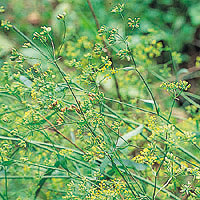Penn Herb Wellness Guide
Bupleurum
 © Martin Wall
© Martin WallParts Used & Where Grown
These Asian plants are part of the Apiaceae (Umbelliferae) family, and resemble dill or fennel. However, bupleurum has long thin leaves rather than the lacy appearance of fennel and dill leaves. The Chinese name for bupleurum, chai hu, means “kindling of the barbarians.” The origin of this name is unclear. The roots of the plant are used in herbal medicine.
- Reliable and relatively consistent scientific data showing a substantial health benefit.
- Contradictory, insufficient, or preliminary studies suggesting a health benefit or minimal health benefit.
- For an herb, supported by traditional use but minimal or no scientific evidence. For a supplement,little scientific support.
Our proprietary “Star-Rating” system was developed to help you easily understand the amount of scientific support behind each supplement in relation to a specific health condition. While there is no way to predict whether a vitamin, mineral, or herb will successfully treat or prevent associated health conditions, our unique ratings tell you how well these supplements are understood by the medical community, and whether studies have found them to be effective for other people.
For over a decade, our team has combed through thousands of research articles published in reputable journals. To help you make educated decisions, and to better understand controversial or confusing supplements, our medical experts have digested the science into these three easy-to-follow ratings. We hope this provides you with a helpful resource to make informed decisions towards your health and well-being.
This supplement has been used in connection with the following health conditions:
| Used for | Amount | Why |
|---|---|---|
Epilepsy (Asian Ginseng, Cassia Bark, Chinese Scullcap, Ginger, Jujube, Licorice, Peony, Pinellia) | 2.5 grams a day of sho-saiko-to or saiko-keishi-to in tea or capsules | The Chinese herb bupleurum is included in two herbal formulas, sho-saiko-to and saiko-keishi-to. Both have been shown to be helpful for epilepsy. |
Hepatitis (Asian Ginseng, Cassia Bark, Chinese Scullcap, Ginger, Jujube, Licorice, Peony, Pinellia) | Take 2.5 grams of sho-saiko-to three times per day | Trials have shown that the bupleurum-containing formula sho-saiko-to can help reduce symptoms and blood liver enzyme levels in people with chronic active viral hepatitis. |
Liver Cirrhosis (Asian Ginseng, Cassia Bark, Chinese Scullcap, Ginger, Jujube, Licorice, Peony, Pinellia) | 2.5 grams of the Chinese herbal formula sho-saiko-to three times daily | The Chinese herb bupleurum is a component of the formula sho-saiko-to, which was shown in one preliminary trial to liver cancer risk in people with liver cirrhosis. |
HIV and AIDS Support (Asian Ginseng, Cassia Bark, Chinese Scullcap, Ginger, Jujube, Licorice, Peony, Pinellia) | Refer to label instructions | The herbal formula sho-saiko-to has been shown to have beneficial immune effects on white blood cells in people infected with HIV. |
Irritable Bowel Syndrome (Dan Shen, Ginger, Schisandra, Wormwood) | Take a Chinese herbal formula containing wormwood under the guidance of a qualified practitioner | A standardized Chinese herbal combination containing extracts from plants including wormwood, ginger, bupleurum, schisandra, and dan shen reduced IBS symptoms in one study. |
Traditional Use (May Not Be Supported by Scientific Studies)
Bupleurum has been used in Traditional Chinese Medicine for thousands of years to help relieve numerous conditions. Most particularly, infections with fever, liver problems, indigestion, hemorrhoids, and uterine prolapse.1
Bupleurum is a key ingredient in the formula known as sho-saiko-to. This is a Japanese kampo or traditional herbal medicine formula based on the traditional Chinese formula xiao-chai-hu-tang. In English, it has been called minor bupleurum formula. Bupleurum makes up 16% of the formula for sho-saiko-to (see below for the complete contents of the formula). Results reported for sho-saiko-to cannot be attributed solely to bupleurum because the other herbs in the formula also contribute.2
Sho-saiko-to (xao-chai-hu-tang or minor bupleurum formula) contains the following:
- Bupleurum falcatum (thorowax) root, 16%
- Paeonia lactiflora (peony) root, 16%
- Pinellia ternata (ban xia) rhizome, 14%
- Cinnamomum cassia (cassia) bark, 11%
- Zingiber officinale (ginger) rhizome, 11%
- Zizyphus jujuba (jujube) fruit, 11%
- Panax ginseng (Asian ginseng) root, 8%
- Scutellaria baicalensis (Chinese scullcap) root, 8%
- Glycyrrhiza uralensis (licorice, gan cao) rhizome, 5%
Copyright 2025 TraceGains, Inc. All rights reserved.
Learn more about TraceGains, the company.
The information presented by TraceGains is for informational purposes only. It is based on scientific studies (human, animal, or in vitro), clinical experience, or traditional usage as cited in each article. The results reported may not necessarily occur in all individuals. Self-treatment is not recommended for life-threatening conditions that require medical treatment under a doctor's care. For many of the conditions discussed, treatment with prescription or over the counter medication is also available. Consult your doctor, practitioner, and/or pharmacist for any health problem and before using any supplements or before making any changes in prescribed medications. Information expires December 2025.


